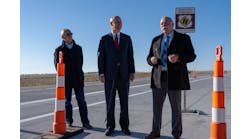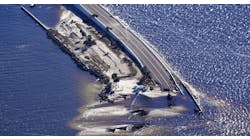By Tim Miller, Contributing Author
Nestled in the middle of downtown Indianapolis sits one of the busiest interchanges in Indiana. Locally known as the North Split, it is the meeting place of I-65 and I-70, often referred to as the “Crossroads of America.”
The Indiana Department of Transportation (INDOT) is preparing to unveil the North Split reconstruction project. The brand-new North Split interchange will provide safer, more free-flowing travel for the tens of thousands of motorists who use the interchange each day. Once complete, the new interchange will consume a smaller footprint and increase the connectivity and walkability of surrounding downtown Indianapolis neighborhoods. The redesigned interchange will improve safety by eliminating weaving and reduce merging, leading to better traffic flow – all without requiring any new right-of-way.
“INDOT is thrilled to open the entire interchange this spring and bring a much-needed and safer upgrade to the Indianapolis community,” said INDOT Commissioner Mike Smith. “The reconstructed North Split will be smaller and more efficient, and will provide a safer interchange for Indianapolis residents, commuters, and those who travel through the state of Indiana.”
Infrastructure design firm HNTB Corporation and Superior Construction are at the helm the $350 million project. Prior to the reconstruction, commuters were consistently sitting in slow or stopped traffic during peak travel times, and dangerous weaving patterns led to crashes and more congestion in the North Split. The interchange was operating at full capacity and crash rates were higher than statewide averages for urban interstates.
The I-65/I-70 North Split interchange was built more than 50 years ago, and the infrastructure was worn out. This is the first time the interchange has been reconstructed since it was built in 1968. As the city grew around it, capacity reached its limit and planning for a new interchange began in 2017. Alternatives were explored and presented to the public in a series of meetings and other outreach. Responding to public comment and engineering need, a solution was found that provided the best balance of safety and mobility while minimizing the need for retaining walls along the interstate.
To make the interchange safer, the design team found ways to eliminate the “weave” pattern at various locations. The result closed access from certain directions at two ramps, with the goal of improving safety and eliminating crashes when the North Split reopens.
INDOT and Superior Construction had a daunting construction task – the interchange is comprised of 50 bridges that needed to be demolished and completely rebuilt. The design-build contract offered flexibility and innovation, and it was decided that the best and most efficient way of constructing the new interchange would be to close it to through traffic for most of the construction.
Along with the challenges that came with so many bridges on the project, the entire world seemed to stop in 2020 when the COVID-19 pandemic began. Designers and other staff began to work from home, but extensive collaboration and innovative communication ensured that the project remained on track.
Supply chain issues delayed delivery of bridge beams and other materials in the aftermath of the pandemic. Nearly 400 beams were needed to complete the project and INDOT and Superior had to find a way to get the materials they required. Ultimately, all the bridge beams were set by November 2022 and 500,000 square feet of concrete bridge decks were poured and complete by December 2022.
Meanwhile, INDOT planned for the nearly 214,000 vehicles that traveled through the North Split daily. INDOT made targeted improvements to I-465, the main detour route, and proactively partnered with the city of Indianapolis to prepare local streets for increased traffic.
A separate, $2.6 million INDOT project upgraded close to 500 traffic signals around Indianapolis. INDOT synced signal timing in the heart of downtown by installing new GPS timecards. They also installed remote control technology in close to 200 signals, giving traffic engineers the ability to aid traffic flow and make changes during construction. INDOT also equipped 17 signals with cameras to monitor for traffic flow issues and adjust signal timing accordingly.
The work could not be completed without innovation. INDOT wanted to ensure that motorists could still access important downtown arteries throughout construction. They pledged to keep certain exits open and maintain access points to downtown during the long-term closure period.
To help with access, designers were able to innovate and use some of the new structures to move traffic. In June of 2022, one of the new bridges was opened to bi-directional traffic. Eventually the structure will serve only I-70 eastbound traffic, but to maintain traffic flow during construction, it was reconfigured to provide two lanes in each direction for I-70 eastbound and westbound.
This kept the flow of traffic moving during construction and provided access to motorists to ease the pain of the interchange closure. With such a big interchange, the project team has utilized drones to survey the construction area and watch progress throughout the closure.
"Innovation, technology, and better ways of working was, and continues to be, at the forefront of our team's strategy for the North Split project,” said Mark Santucci, Superior survey project manager. “In 2020, we commissioned a drone company which offered 3D mapping footage and analytics to assist us throughout the project. This gave our teams unique insights and a weekly bird’s-eye view of our work and progress.”
The design-build North Split contract focuses on connecting the communities that surround the existing interchange. Neighborhood listening sessions and surveys during the environmental phase of the project indicated the public wanted a natural approach to landscaping and liked the idea of an “urban forest.”
The original interchange space, about 185 acres, was built to accommodate a possible fourth leg that was never built. INDOT is repurposing this land as part of the North Split project to add greenspace, walking trails, and 3 million square feet of urban forest, or an area of the project that is being transformed by planting and landscaping.
Plantings within the North Split interchange include native grass, small shrubs, larger deciduous shrubs, ornamental trees, and shade trees, many which are native to the area. Final landscape plans were updated and presented to stakeholders in November 2021 and planting began in the fall of 2022. Planting and aesthetic treatments will continue throughout 2023.
New greenery will not be the only noticeable change. To shrink the interchange footprint, designers planned to build the interchange at higher elevation than it was before.
“We have design and construction capabilities now that weren’t available when the North Split was first built,” said Brian Shattuck, INDOT project manager. “We are able to be innovative and use our space more efficiently to shrink the interchange and bring in more landscaping and trails for the community.”
The increased height of each bridge will impact the city economically, as trucks will be able to move more freely through downtown for deliveries. To achieve this new height, the team brought in 1 million cubic yards of dirt to build the new infrastructure. INDOT estimates this new design will enhance economic development as businesses will recognize more efficient traffic operations.
When the North Split opens, those traveling on I-65 or I-70 through the Crossroads of America will benefit from a safer, more efficient interchange, and the local community will benefit from a reduced footprint, improved connectivity, and enhanced landscaping benefitting the state’s capital city. R&B
Timothy Miller is a Senior Project Manager at HNTB. He served the Indiana Department of Transportation for nine years before joining HNTB in 2001.




